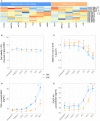Transcriptomic and barrier responses of human airway epithelial cells exposed to cannabis smoke
- PMID: 31646766
- PMCID: PMC6811686
- DOI: 10.14814/phy2.14249
Transcriptomic and barrier responses of human airway epithelial cells exposed to cannabis smoke
Abstract
Globally, many jurisdictions are legalizing or decriminalizing cannabis, creating a potential public health issue that would benefit from experimental evidence to inform policy, government regulations, and user practices. Tobacco smoke exposure science has created a body of knowledge that demonstrates the conclusive negative impacts on respiratory health; similar knowledge remains to be established for cannabis. To address this unmet need, we performed in vitro functional and transcriptomic experiments with a human airway epithelial cell line (Calu-3) exposed to cannabis smoke, with tobacco smoke as a positive control. Demonstrating the validity of our in vitro model, tobacco smoke induced gene expression profiles that were significantly correlated with gene expression profiles from published tobacco exposure datasets from bronchial brushings and primary human airway epithelial cell cultures. Applying our model to cannabis smoke, we demonstrate that cannabis smoke induced functional and transcriptional responses that overlapped with tobacco smoke. Ontology and pathway analysis revealed that cannabis smoke induced DNA replication and oxidative stress responses. Functionally, cannabis smoke impaired epithelial cell barrier function, antiviral responses, and increased inflammatory mediator production. Our study reveals striking similarities between cannabis and tobacco smoke exposure on impairing barrier function, suppressing antiviral pathways, potentiating of pro-inflammatory mediators, and inducing oncogenic and oxidative stress gene expression signatures. Collectively our data suggest that cannabis smoke exposure is not innocuous and may possess many of the deleterious properties of tobacco smoke, warranting additional studies to support public policy, government regulations, and user practices.
Keywords: Calu-3 cells; Marijuana; Transepithelial electrical resistance; interferon stimulated genes; oxidative stress.
© 2019 The Authors. Physiological Reports published by Wiley Periodicals, Inc. on behalf of The Physiological Society and the American Physiological Society.
Conflict of interest statement
None declared.
Figures




References
-
- Amatngalim, G. D. , Schrumpf J. A., Henic A., Dronkers E., Verhoosel R. M., Ordonez S. R., et al. 2017. Antibacterial defense of human airway epithelial cells from chronic obstructive pulmonary disease patients induced by acute exposure to nontypeable haemophilus influenzae: modulation by cigarette smoke. J. Innate Immun. 9:359–374. - PMC - PubMed
-
- Auerbach, O. , Hammond E. C., and L. Garfinkel. 1979. Changes in bronchial epithelium in relation to cigarette smoking, 1955–1960 vs. 1970–1977. N. Engl. J. Med. 300:381–385. - PubMed
-
- Aufderheide, M. , Scheffler S., Ito S., Ishikawa S., and Emura M.. 2015. Ciliatoxicity in human primary bronchiolar epithelial cells after repeated exposure at the air‐liquid interface with native mainstream smoke of K3R4F cigarettes with and without charcoal filter. Exp. Toxicol. Pathol. 67:407–411. - PubMed
Publication types
MeSH terms
Substances
LinkOut - more resources
Full Text Sources
Medical
Molecular Biology Databases

